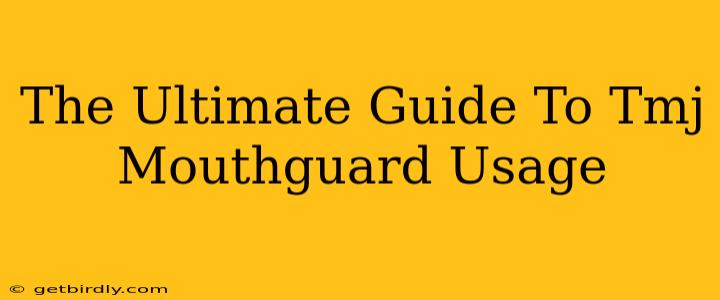The Ultimate Guide to TMJ Mouthguard Usage
Temporomandibular joint (TMJ) disorders affect millions, causing jaw pain, headaches, and clicking sounds. While various treatments exist, custom-fitted or boil-and-bite mouthguards are often recommended to alleviate symptoms and prevent further damage. This comprehensive guide explores everything you need to know about using a TMJ mouthguard effectively.
What is a TMJ Mouthguard and How Does it Work?
A TMJ mouthguard is an oral appliance designed to reposition the jaw, relax the muscles, and reduce stress on the temporomandibular joint. Unlike sports mouthguards, which primarily protect teeth, TMJ mouthguards are specifically engineered to address the underlying causes of TMJ disorders. They work by:
- Realigning the jaw: The mouthguard gently guides the jaw into a more comfortable and stable position, reducing strain on the joint.
- Reducing muscle tension: By keeping the jaw in a relaxed position, the mouthguard prevents clenching and grinding (bruxism), which are major contributors to TMJ pain.
- Protecting teeth: While not their primary function, they offer some protection against wear and tear from clenching and grinding.
There are two main types: custom-made and boil-and-bite. Custom-made mouthguards are created by a dentist based on impressions of your teeth, offering a superior fit and comfort. Boil-and-bite mouthguards are readily available over-the-counter, offering a more affordable but less precise option.
How to Choose the Right TMJ Mouthguard
Selecting the right mouthguard is crucial for effective TMJ treatment. Consider these factors:
- Type of Mouthguard: Custom-made mouthguards provide the best fit and comfort but are more expensive. Boil-and-bite options are convenient and cheaper but may not fit perfectly.
- Material: Mouthguards are typically made from soft, flexible materials like silicone or ethylene vinyl acetate (EVA). Consider comfort and durability.
- Dentist Recommendation: A dentist can assess your specific needs and recommend the most appropriate type and design of mouthguard.
How to Use a TMJ Mouthguard Effectively
Proper usage is vital for maximizing the benefits of your TMJ mouthguard.
- Cleaning: Clean your mouthguard daily with cool water and a soft-bristled brush. Avoid using hot water, which can damage the material.
- Wearing Schedule: Your dentist will recommend a wearing schedule. It might be full-time initially, gradually decreasing as symptoms improve. Consistent use is key.
- Comfort: Initially, you might experience some discomfort. If pain persists or increases, consult your dentist.
- Storage: Keep your mouthguard in a clean, protective case when not in use.
What are the Potential Side Effects of Using a TMJ Mouthguard?
While generally safe, some users experience minor side effects, including:
- Increased saliva production: This is often temporary and resolves as you adjust.
- Slight speech impediment: Again, this usually subsides with time.
- Discomfort: Initially, you might experience mild discomfort.
What if my TMJ mouthguard doesn't fit properly?
An ill-fitting mouthguard can be uncomfortable and ineffective. If you experience persistent discomfort or the mouthguard feels loose or too tight, consult your dentist for adjustments or a new appliance.
How long does it take to see results from using a TMJ mouthguard?
The timeframe varies depending on the severity of your TMJ disorder and individual response. Some people experience relief within days, while others may require several weeks or months. Consistent use is crucial for optimal results.
Are there any alternatives to TMJ mouthguards?
Other TMJ treatment options include physical therapy, medications (muscle relaxants, pain relievers), and in some cases, surgery. Your dentist or doctor can determine the most suitable approach based on your individual circumstances.
How often should I replace my TMJ mouthguard?
The lifespan depends on the type and material. Boil-and-bite guards typically need replacement every few months due to wear and tear, while custom-made mouthguards may last longer but should be checked regularly by your dentist.
Conclusion
TMJ mouthguards can be an effective, non-invasive treatment option for managing TMJ disorders. By understanding how to choose, use, and care for your mouthguard, you can significantly improve your comfort and alleviate symptoms. Remember to consult with your dentist or doctor for personalized advice and ongoing monitoring. They can assess your specific situation and guide you towards the best course of action for long-term TMJ health.

